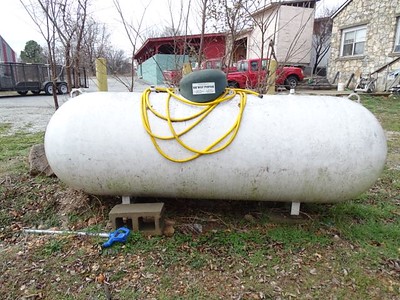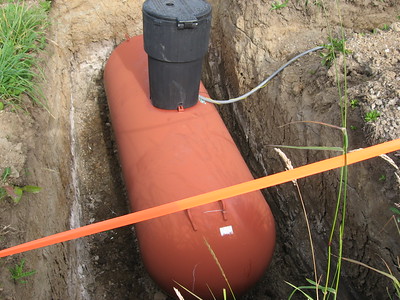
If you’re wondering what the optimal pressure for a 250 gallon propane tank is, you’re not alone. This is a common question among propane users.
The optimal pressure for a 250 gallon propane tank is between 100 and 200 psi. This range of pressure will allow for proper functioning of appliances and sufficient heat output. This range ensures that the fuel will be able to vaporize properly and will not be too dense, which can lead to problems with the regulator or other components of the system.
Too much pressure can cause appliances to work less efficiently and can be a safety hazard. Too little can result in insufficient heat output and decreased performance of appliances.
It is important to note that the optimal pressure for a propane tank can change depending on the season. In colder weather, it is typically necessary to increase the pressure in order to maintain proper vaporization. Conversely, in warmer weather, it may be necessary to decrease the pressure in order to prevent overfilling.
As always, it is best to consult with your propane supplier or a qualified technician before making any changes to your system. They will be able to help you determine the best pressure for your specific situation and ensure that your system is operating safely and efficiently.
Read related article: 5 Simple Ways How to Move 250 Gallon Propane Tank
What Constitutes ‘Optimal Pressure’?
Optimal pressure in a propane tank, such as a 250-gallon tank, is the pressure range at which the propane remains safe and efficient for use. This range is crucial for both operational efficiency and safety. Propane, being a liquefied petroleum gas, exists in both liquid and vapor forms inside the tank. It ensures a steady flow of gas out of the tank and maintains the fuel’s integrity.
Factors Influencing Optimal Pressure
- Temperature: The most significant factor affecting pressure is ambient temperature. As temperature rises, propane expands, increasing the pressure inside the tank. Conversely, in colder conditions, it decreases due to the contraction of the propane.
- Usage: The rate of propane usage also influences tank pressure. Frequent or high-volume usage can lower it more rapidly, as the liquid propane level decreases, leaving more space for vapor.
- Environment: Environmental factors, such as altitude and humidity, can also impact the PSI in a propane tank. Higher altitudes might result in lower atmospheric pressure, affecting the propane tank’s internal pressure.
Typical Pressure Range
For a 250 gallon propane tank, the typical range under normal conditions (around 60-70°F) is between 100-200 psi (pounds per square inch). However, this range can fluctuate based on the factors mentioned above. For example:
- In Warm Conditions: On hot days, the pressure can rise significantly, sometimes exceeding the typical range. Propane tanks are equipped with relief valves to release excess pressure and prevent tank rupture.
- In Cold Conditions: In cold weather, it can drop below 100 psi, which might affect the performance of propane-fueled appliances.
Maintaining the optimal pressure is crucial for the safe and effective use of propane as a fuel. Regular monitoring and understanding of the influencing factors can help prevent safety hazards and ensure the longevity of the tank and connected appliances.
Read related article: 250 Gallon Propane Tank for Home (Does This Size Fit Your Need)
At 100-200 PSI Ensures That the Liquid Propane Gas Remains in a Liquid State
Propane is a gas at standard temperature and pressure (STP). However, it can be compressed into a liquid state at high pressures. In order to maintain the liquid state, propane must be kept under pressure.
At 100-200 PSI, the propane will remain in a liquid state. This is because the molecules are being held together more tightly, due to the high pressure. If it were to drop, the propane would turn back into a gas.
This is important to know because it can be dangerous to store or transport propane in its gaseous form. When compressed into a liquid, propane is much safer to handle.
When the PSI is Below 100 PSI, the Pressure is Low
If the propane tank PSI is below 100 PSI, the pressure is low. This can be caused by a number of factors, such as a malfunctioning regulator, a leak in the tank, or simply because the tank is running low on propane.
If you notice that the propane tank PSI is below 100 PSI, it’s important to take action immediately. If the pressure is too low, it can cause the propane to vaporize and escape from the tank, which can be extremely dangerous.
There are a few things you can do to increase the pressure in your propane tank:-Turn up the regulator: This will increase the flow of propane into the tank and help to raise the pressure.
- Check for leaks: A leak in the tank or in the connections can cause the propane to escape and lower the pressure. Make sure there are no leaks before trying to increase it.
- Fill up the tank: If the propane level in the tank is low, this can also cause the pressure to drop. Fill up the tank with fresh propane to raise it.
Read related article: Can You Transport A 250 Gallon Propane Tank? (4 Methods)
When the PSI is Above 200 PSI, the Pressure is Too High
If the propane tank PSI is above 200 PSI, it is too high. This can be caused by many things, such as a faulty regulator, a leak in the system, or even overfilling the tank. If this happens, it’s important to take action immediately to avoid an explosion.
If you think the pressure in your propane tank is too high, the first thing you should do is turn off the gas. Then, call a qualified technician to come and check the system. They will be able to determine the cause of the high pressure and fix it. In the meantime, don’t use any gas appliances and make sure all flames are extinguished.
Pressure Inside the Tank Fluctuates based on the Outside Temperature
As the temperature outside fluctuates, so does the pressure inside a propane tank. This is because propane is a gas, and gas expands when it gets warmer and contracts when it gets cooler. The pressure inside the tank will rise and fall based on the temperature changes, but it should stay within a safe range.
If you’re worried about the pressure inside your propane tank, you can always check the gauge to see what the current reading is. If it is getting too high or too low, you can adjust the regulator to compensate. Just be sure to keep an eye on the gauge so that you don’t over or under-correct.
How to Check the Pressure in Your Propane Tank
The best way to check the pressure in your propane tank is with a gauge. You can find a gauge at most hardware stores. To use the gauge, simply attach it to the valve on your propane tank. Then, open the valve and check the reading on the gauge. The ideal range for most appliances is between 10 and 15 psi.
If the reading on your gauge is outside of this range, it’s time to adjust the pressure in your tank. To do this, you’ll need a regulator. You can find regulators at most hardware stores as well. Once you have a regulator, attach it to the valve on your propane tank. Then, open the valve and adjust the knob on the regulator until the reading on your gauge is in the ideal range.
To Make a Conclusion
Understanding the optimal pressure for a 250 gallon propane tank is essential for both safety and efficiency. Generally, this ranges between 100-200 psi, but it can vary with changes in temperature, usage patterns, and environmental conditions. Regular monitoring and awareness of these factors help ensure the safe and effective use of your propane tank.
By keeping a close eye on the pressure and adapting to any changes, you can maintain your propane tank in top condition, ensuring it works well for all your needs. Remember, the key to optimal propane tank management lies in balancing safety with efficiency, making it crucial to stay informed and proactive about your tank’s pressure levels.
This approach not only extends the life of your tank but also guarantees that you get the most out of your propane supply. In summary, the optimal pressure for a 250 gallon propane tank is not a static number but a dynamic range that requires attention and care. By respecting this, you can enjoy a reliable, safe, and efficient propane system, whether it’s for heating, cooking, or any other application.

Mike is an experienced propane technician with over 15 years of professional experience in the field. He has dedicated his career to helping customers with their propane needs, from installation to maintenance and repair. Together with Jeremy, he co-founded this website to provide useful information and guidance to customers seeking reliable propane services.



